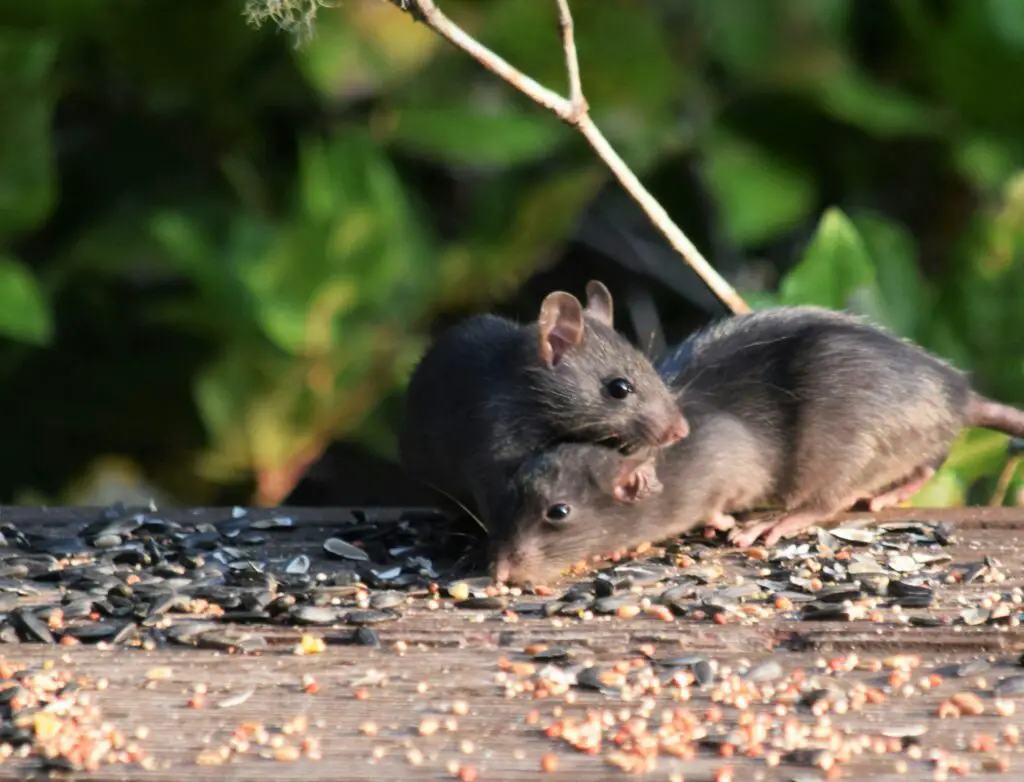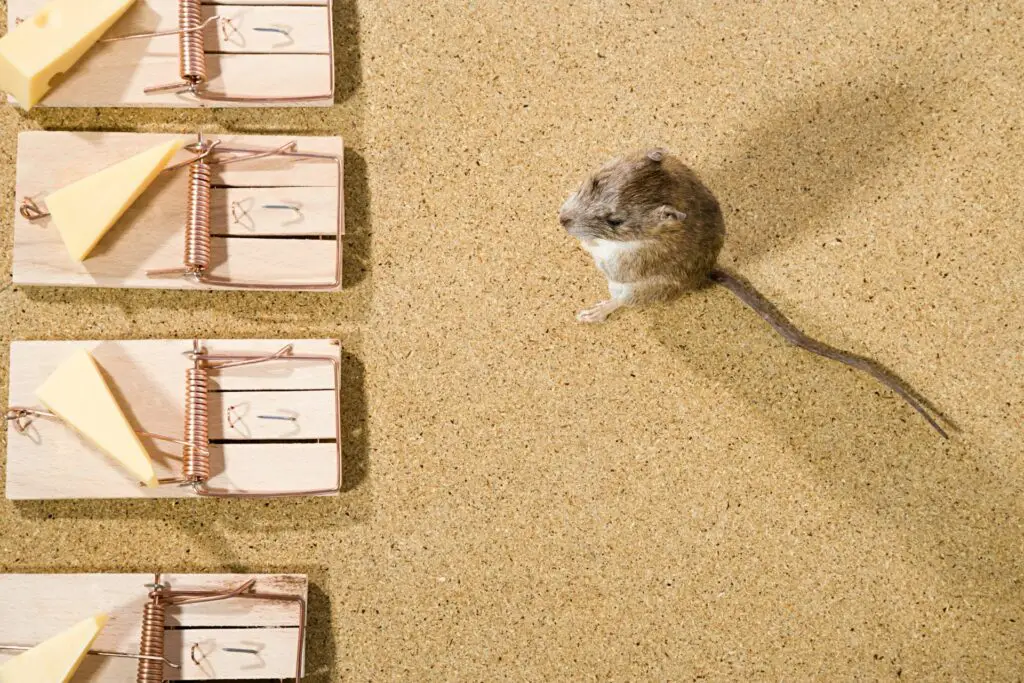There are many ways to get rid of mice. However, some of them are unsafe for your pets. This guide reveals natural, safe ways to eliminate mice from your living spaces without harming your pets or family.
Moreover, if you are unsure if a method is safe for your pets and children, ask a professional.
Recognizing a Mouse Infestation in Your Home
Identifying mouse infestations on time is crucial to preventing them from becoming unmanageable and eliminating them from your home. But how do you know if you have mice in your home?
Search for signs like gnaw marks and droppings, and consider using bait stations. Other signs include:
Nightly Noises and Mouse Sightings
The sound of scurrying in the walls at night or the glimpse of a mouse darting across the room are strong indicators that you have unwelcome guests.
Discovering Mouse Droppings and Tracks
Finding mouse droppings or footprints in dusty areas can confirm the presence of mice and help you gauge the level of infestation.
Assessing the Extent of Damage
Inspect your home for damage, such as chewed items and nests, to understand the severity of the mouse’s presence.
Chewed Wires and Furniture
Chewed wires and gnawed furniture signify a rodent issue and pose a fire risk and potential safety hazard for pets.
Nest Materials and Hidden Nests
Discovering nesting materials like shredded paper or fabric can lead you to hidden mouse nests, often tucked away in secluded spots.

Preventative Measures to Keep Mice at Bay
Prevention is the best strategy to deter mice and avoid mouse problems, keeping your home and pets safe without resorting to dangerous methods.
Sealing Entry Points to Thwart Intruders
Blocking entry points is a long-term solution that will deter mice and save you from future rodent troubles.
Cleanliness
Maintaining a clean environment is essential to discouraging mice from invading your home. Using peppermint oil in your cleaning routine can help deter mice, as they hate the smell. However, avoid bait stations that pose risks to pets. Instead, consider kitty litter that tells of rodent activity without danger. You should know that mice eat anything, so keep your home tidy and use it safely with pet- and children-friendly products.
Proper Food Storage Solutions
Storing food in airtight containers is crucial to cut off the food supply that could attract mice to your home.

Pet-Friendly Mouse Deterrents and Traps
Choose traps wisely to trap the mouse without causing harm to pets. Avoid snap traps and glue traps; they pose risks to curious animals.
Natural Repellents
Natural repellents like peppermint oil can be an effective way to keep mice away without jeopardizing pet safety.
Peppermint Oil and Camphor: Scents That Repel
Mice detest the smell of peppermint, making peppermint oil a pet-safe option to deter these pests. Similarly, the strong scent of camphor is offensive to mice and can serve as a repellent. Apply these natural oils around your home; focus on mouse activity areas to keep the rodents at bay.
Humane Trapping: Live and Electrical Options
Consider live traps or electrical options as a kind approach to rodent control. Live traps capture mice without injury, allowing for release far from your home, and modern electrical traps provide a quick and humane end.
Proper Placement of Humane Mouse Traps
Successful humane trapping hinges on strategic placement. Set traps along walls and near potential entry points or food sources. Check and empty live traps frequently to minimize stress on captured mice and ensure traps are inaccessible to pets.
Understanding the Mechanics of Electrical Traps
Electrical traps attract mice with bait, then deliver a swift electrical charge to euthanize the rodent. The designs of these traps prevent pets from accessing them. However, you should monitor them regularly to remove captured mice and maintain their effectiveness.
Implementing a Safe Mouse Control Routine
Avoid harm to pets by eschewing poison for alternatives like peanut butter in traps, which are irresistible to mice but non-toxic to pets. Implementing a routine check of traps helps manage the mouse population without endangering your furry friends.
Alternatives to Toxic Bait Stations
Choose safe bait traps and place them in areas where your pet cannot access them. Opt for tamper-resistant stations and non-toxic baits to protect your family while controlling rodent populations.
Ultrasonic Emitters: A Non-Invasive Repellent Method
Ultrasonic emitters create a sound environment that is intolerable to mice yet inaudible to humans and most pets. Though not effective as a standalone solution, pairing these devices with other methods, like the spicy scent of cayenne pepper, can enhance your deterrent efforts.

Step-by-Step Guide to Using Kitty Litter as a Deterrent
Using kitty litter tells rodents that a predator may be nearby. The smell of the kitty litter can be a natural deterrent, making mice think twice before entering your space. This guide will show you how to use kitty litter effectively.
Choosing the Right Types of Litter
Select unscented, natural kitty litter to avoid introducing intense artificial smells into your home that could irritate pets or family members. Choose a type that clumps well for easy cleanup and maintenance.
Strategic Placement Around the Home
Place kitty litter where mice are likely to enter, such as near doors, windows, or gaps in exterior walls. Consider pairing it with physical barriers like steel wool to plug entry points for a layer of protection against rodent intrusion.
Conducting Regular Check-Ups in Vulnerable Areas
Inspecting your home is crucial, especially areas that provide shelter and food for mice. Be vigilant in your efforts to maintain a mouse-free environment for the safety of your pets and family.
Inspecting the Garage and Basement for Signs of Mice
Look for evidence of mice in your garage and basement, including damaged food packaging or prints on dusty surfaces. These signs indicate active infestations and should prompt immediate action to control and prevent further intrusion.
Long-Term Strategies for a Rodent-Free Home
Maintaining a rodent-free home requires a multi-faceted approach, including ongoing prevention strategies, regular home maintenance, and remaining vigilant about potential new infestations.
Adopting a Pet: Can Cats and Dogs Deter Mice?
While cats are natural hunters who may hunt mice, and some dogs may chase rodents, relying solely on pets for control is not foolproof. Ensure pets do not have access to toxic substances like rat poison, and supplement their presence with other rodent deterrent methods.
Professional Services: When to Call in the Experts
When DIY methods fail or infestations persist, it’s time to contact a professional pest control company. These experts can assess the situation, develop a tailored plan, and use advanced techniques to rid your home of rodents
Summary: Ensuring a Mice-Free Environment Without Risk to Pets
As pet owners, ensuring the safety of your beloved animals while tackling mouse infestations is paramount. You can achieve a mice-free home through diligent prevention and cautious elimination methods that pose no threat to pets. It’s about finding a balance between being thorough in your approach to rodent control and using pet-friendly and non-toxic tactics.
To manage mouse sightings and prevent infestations effectively, start with simple steps: seal doors and windows, store food away securely, and maintain clean spaces free of food crumbs. Use peanut butter in traps as a non-toxic bait, and always secure your trash cans. When you apply these actions consistently, you can eliminate mice from your living spaces without putting your pets at risk.


